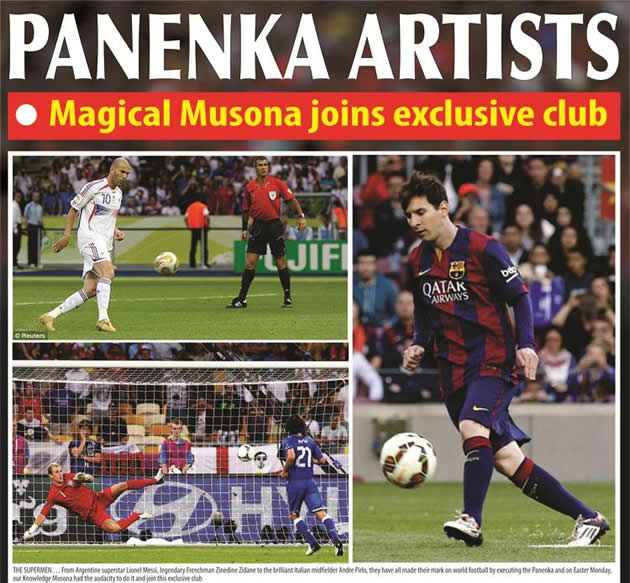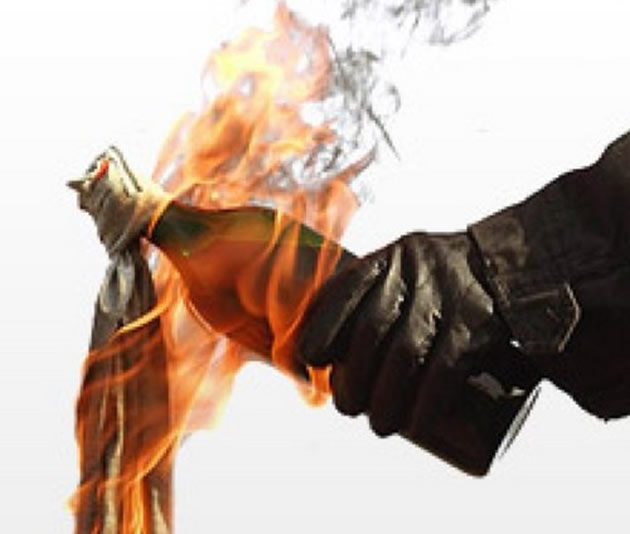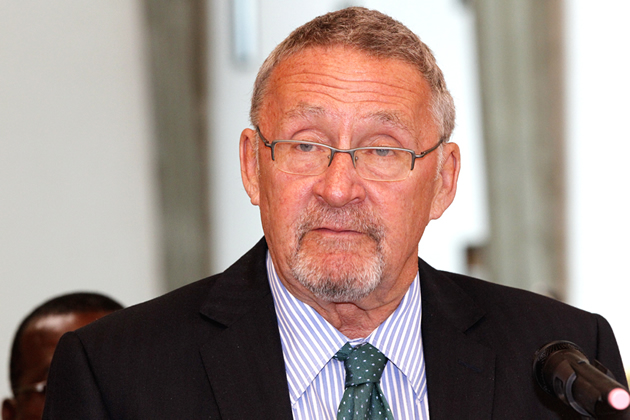Panenka artists…Magical Musona joins exclusive club

 Robson Sharuko Senior Sports Editor
Robson Sharuko Senior Sports Editor
EXACTLY 40 years after Czech international footballer Antonin Panenka introduced the “panenka penalty” to the world in the 1976 European Championships final, Zimbabwean ace Knowledge Musona added his name to an illustrious club of players who have successfully performed such an audacious execution from the spot on Easter Monday.
The Warriors golden boy, in a golden shirt, made time appear to stand still, freezing the emotions of thousands of fans inside the National Sports Stadium and millions more following the live broadcast of the game on television, as his cheeky penalty kick floated goalwards.
Zimbabwe held its breath and for good reason too.
With a make-or-break 2017 Nations Cup qualifier on the line and a gritty Swaziland — who have punched above their weight in this fairytale campaign and shown how much they have improved in the last few years — having largely frustrated their hosts, the referee’s decision to award the Warriors a penalty presented Zimbabwe with a golden chance for a vital breakthrough.
The intensity of the pressure on Musona, as he lined up to take that spot kick was massive, and with the hopes of an entire nation resting on the Belgium-based forward, the leader of the team’s attack in the past five years, there was no margin of error.
On June 5 in 2011, Musona had found himself in a similar situation.
With the crucial 2012 Nations Cup qualifier against Mali at Rufaro staggering towards a draw, which would have ended the Warriors’ quest for a place at the finals, Ovidy Karuru burst into the opposition penalty area, in the dying moments of that tie, before his advance was ended in illegal fashion.
South African referee Daniel Bennet pointed to the spot and as an estimated 40 000 Zimbabwean fans held their breath, inside that compact stadium, Musona stepped up to take responsibility.
He decided to go with power and placement, but the Malian goalkeeper guessed the right direction and as his hand made contact, pushing the ball out for a corner, a part of the thousands of the Warriors’ fans inside the stadium, and millions watching the game live on television, died.
The silence that engulfed Rufaro was deafening as the fans cursed the hands of fate, cruel fate, but the Malians’ celebrations were premature with the assistant referee ruling that the ‘keeper had moved forward, before the penalty had been taken and Bennet ordering a replay.
This time Musona got it right and the Warriors’ dream, which appeared to have been shattered just a few minutes earlier, was alive again as Rufaro celebrated a milestone victory.
On Easter Monday, five years later, Musona was back in that pressure situation, knowing that if he failed to convert this penalty, it was likely to deflate his team — for the remainder of the game — and blow wind into the sails of the Swazi players.
What followed, as the KV Oostende forward powered Zimbabwe into the lead, a decisive breakthrough that made all the difference given that this was a Swazi team that had come on a mission to frustrate their hosts and grab a point, forcing Sihlangu to be adventurous, in search of an equaliser and open a number of gaps in their defence.
Musona didn’t go for power, this time around, choosing to go for dexterity, dropping his shoulders as if he was firing into the left corner of the Swazi ‘keeper and then — as the goalminder slumped to the ground — the striker clipped the ball, with the deftest of touches, to give it flight, and just enough power, for it to nestle into the middle of the goal.
Given the burden of pressure that he was carrying, in such a big match, for Musona to do what he did, trusting his instincts and skills to score such an outrageous goal, just having the belief that he could do it and executing the move with such brilliance it all bordered on arrogance, was the stuff that separates special players from the ordinary ones.
It was such a superb execution that the Swazi ‘keeper, brilliant all afternoon, was left an embarrassed man, slumped on the surface, as he watched the ball spin home through the space he had been covering before he was fooled to go down by the Warriors’ talisman.
The technique is called the Panenka and Wikipedia describes it as a “technique used in penalty kick-taking in which the player, instead of kicking the ball directly into the goal, gives a subtle touch underneath the ball, causing it to rise and fall within the goal thus deceiving the goalkeeper.” The name is derived from the Czech player, Antonin Panenka, who “presented this technique to the world in the 1976 European Championship finals, when he beat German goalkeeper Sepp Maier.
“The aim of the technique is not to chip the ball over the goalkeeper, but to take advantage of the fact that many goalkeepers will dive to either side of the goal in anticipation rather than determining the trajectory of the kick.
“It is a very risky technique, because the subtle touch on the ball gives it a very slow speed, thus allowing the goalkeeper to move back from where he jumped to or even just stay at the same spot and wait for the ball to easily fall on his hands.
“The move is known for only being used by fearless players who dare to risk missing the kick. Because of the high risk of missing the kick, some players that used the Panenka kick were criticised by the media or their team’s members and supporters for being frivolous, using an unnecessary method to score the goal.”
Panenka, himself, feels that there has never been a better execution of his move than the one from Argentine superstar Lionel Messi when the Barcelona forward deceived Getafe ‘keeper Vicente Guaita, scoring the first of his two goals that day in April last year, as the Catalans giants powered to a 6-0 victory in a La Liga match.
Then, of course, there was Zinedine Zidane in the 2006 World Cup final against Italy when the French superstar went for the Panenka with the ball kissing the crossbar and then bouncing over the goal line. Andre Pirlo, the Italian midfield star, also chose the Panenka, in the penalty shoot-out battle against England in the Euro 2012 quarter-finals, sending ‘keeper Joe Hart to the floor and then chipping the ball home.
“Humiliation has never been more gracefully inflicted than the moment Andrea Pirlo dinked his penalty past Joe Hart on Sunday evening,” football writer, Matt Dickinson, penned in the Times of London.
“Exquisitely gentle, that chip also carried crushing intent, according to its creator, with Pirlo revealing that he had conjured it specifically to douse the fire in Hart.” Dickinson could even have been writing about Musona after his beautiful execution on Easter Monday showed that, in an era where Zimbabwe football is usually associated with negativity, it still retains a very beautiful, if no poetic side, to it.











Comments